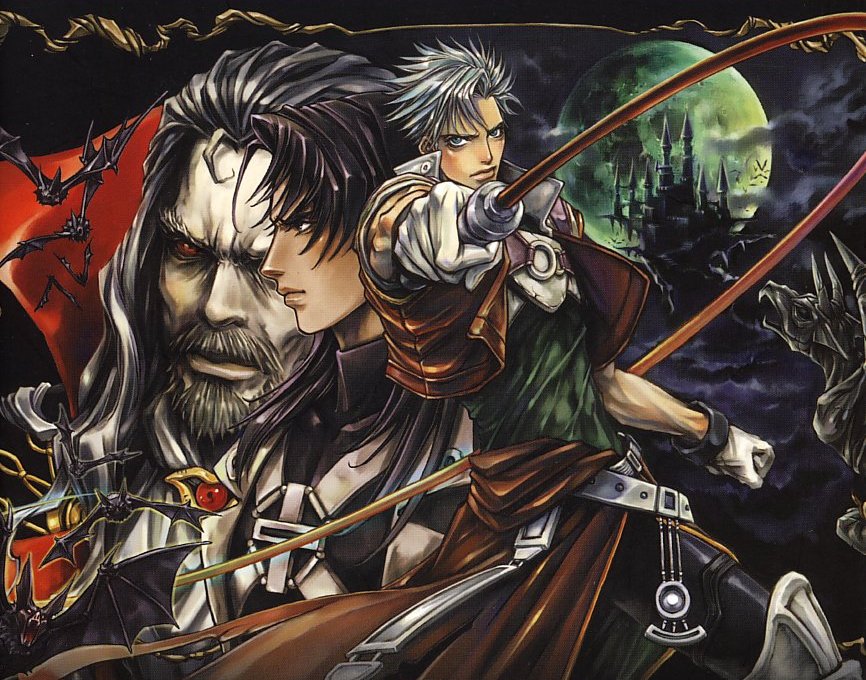
In the late 90's the Castlevania series was largely known for two things; the original games starring vampire-slaying protagonist Simon Belmont, and the Playstation-era sequel Symphony of the Night, which followed Dracula's own son Alucard as he sought to end his own father's reign of terror. Some would also argue that, at least in homeland Japan, Rondo of Blood was a notable early high point in the series. But up til the turn of the century, these were Konami's crowning achievements with Castlevania.
Symphony of the Night itself, being the most popular game in the series, was a bit of an oddity at this point. Every Castlevania game prior to it was fundamentally an old-school action-platformer, complete with power-ups and stock lives. When Koji Igarashi programmed Symphony of the Night he took cues from the Metroid games, making the majority of the games going forward into more unique adventure-platformers with RPG elements. Gone were stock lives and static gameplay, replaced with save points and a depth of gameplay.
Circle of the Moon was the first major Castlevania game to see release following the era of SotN. It is only the second 'Metroidvania'-style Castlevania game, released a number of years after its successor. It then follows that the success of CotM is largely responsible for the direction the series as a whole took over the following years. It was also the first Castlevania game I owned, and perhaps my favorite.
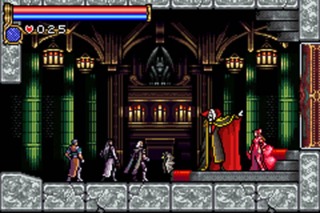
CotM begins abruptly enough, with Dracula being resurrected by his hardcore demon follower Camilla. Morris Baldwin, a veteran demon hunter, returns to the dark lord's lair sensing the disturbance, but is too late to stop the revival.
Baldwin brings along his two apprentices; his own son Hugh, and the game's main protagonist - Nathan Graves. Graves' parents were Baldwin's friends and fellow demon hunters, who died years ago the last time they fought Dracula.
This reunion of surviving slayer and revitalized dark lord is cut short, however, when Dracula banishes Nathan and Hugh to another section of his castle, and speaks business with his would-be assassin.
Within a few minutes the plot is laid out, completed by Hugh's decision to split up and brashly face Dracula and save his father on his own. The icing on the cake is that Morris chose to pass on the family heirloom, the Hunter Whip, to Nathan rather than Hugh, causing Hugh to resent the player character.
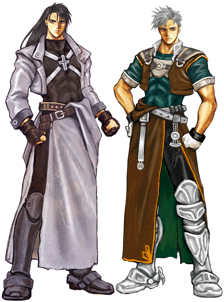
From that point on, CotM is a worthy and exceptional successor to SotN, and is perhaps in many ways actually a better game than its forebear. From that point on, Nathan can brandish his whip in familiar fashion, and use sub-weapons like daggers and axes with the expenditure of heart points. But he can also find and equip different armor and accessories. He can gain experience points and level up, increase his stats, and collect various upgrades to help him progress through the different sections of the castle. And several different demons and boss monsters await him at each section of the castle.

Obviously, there are some places where CotM falters in comparison to its predecessor. To begin with, CotM is a handheld game developed for the Gameboy Advance, as a launch title no less. This means that the game lacks the sheer power and capacity of a Playstation game. It isn't quite as big of an adventure as SotN, though it's by no means a brief outing. And there are some times in the game when the visuals are difficult to make out, or the animations move so quickly that it's difficult to appreciate all of the beauty of the game's artwork.
While Nathan can equip different body armor and accessories, he is unable to upgrade the Hunter Whip in any way or equip other kinds of weapons. There is also no way to sell unwanted overstock items from the player inventory, which can be somewhat obnoxious. And notably, Nathan's character sprite can be difficult to see on the small screen of the Gameboy Advance at times, due to the game being so dark in color palette.

What makes Circle of the Moon truly unique is its ambitious gameplay feature, the DSS - or Dual Set-Up System. The DSS features 20 different cards Nathan can find in his quest from monster drops, separated into two groups - Action cards, and Attribute cards. Each action card can be paired up with an attribute card, and when activated grants Nathan a special ability.
Combining the Mercury card with the Salamander card, for example, causes Nathan's whip to become fire-elemental and deal more damage to most enemies. There are many other kinds of combinations as well, for example, combining Jupiter with Mandragora enables Nathan to heal himself while stationery, and mixing Mars with Golem lets him attack with a slow but powerful hammer attack. DSS cards consume mana while active, and some consume more or less than others'. Gathering various mana potions hidden throughout the castle helps to increase the overall amount of time Nathan can keep these abilities active for.

The DSS system is a fantastic and varied gameplay system, and adds a lot to CotM as a side point. It is ambitious and unique. But only certain combinations of cards ever end up being especially useful or worth the hassle of collecting certain cards for. Elemental properties, something which the cards are based heavily upon, hardly come into play in the game, meaning there isn't much different in damage output between a lot of the attacks. An even bigger complaint is that there is nothing in the game that tells you what card combinations will do before you use them. A better reference guide in-game could have remedied this, but unfortunately a lot of trial-and-error and online guides are necessary for making knowledgeable use of the cards.
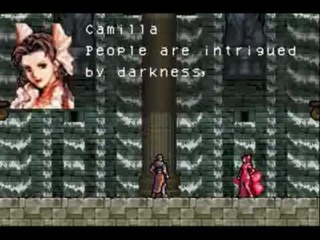
CotM ends up being, despite its minor flaws, one of the most memorable and unique games in the series. One area where the game especially shines is in its soundtrack. There are a few remixes of older songs from the series, but it's mostly all new stuff. And it does a fantastic job at setting the mood of the game world and evoking emotion.
The story, while by no means complex, is surprisingly good for featuring such a small cast of characters and such simple archetypes. The artwork is great, despite a few minor gripes mentioned up above. And the gameplay is superb and very well-polished, considering that this is a GBA launch title, and only the second Castlevania game to follow the formula of Symphony of the Night.
...And Koji Igarashi, who developed SotN, had no involvement whatsoever with the development of Circle of the Moon. This was Konami basically moving the series forward.
It's funny when you consider that this game is very good, and Igarashi was highly critical of it. He was so against this game, in fact, that he removed it from the official Castlevania timeline of events for some time. ...And still, he copies ideas from this game when making sequels to it. He copied the best-friends-turned-rivals approach with Harmony of Dissonance's Juste and Maxim. He copied the elemental approach when he made the magic tomes system for that game, which worked in conjunction with sub-weapons to create different attacks. He copied the DSS system again, with more success, when he created the character of Soma Cruz and the Soul Dominance system for Aria and Dawn of Sorrow. It's clear that this one game, CotM, is to thank for Igarashi's competitive determination to build a better Castlevania game.
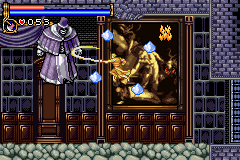
While the argument may exist for years as to whether or not Circle of the Moon is a canonical Castlevania game, to me it is a fantastic example of what Castlevania should be. Perhaps it came along at just the right time, to prove that Igarashi isn't the only guy responsible for making these great games. Indeed, when a game series is out of the hands of the very people who created it, sometimes that is a great way for innovation to take place and new ideas to thrive. After all, that's just how Igarashi got his start when he took the helm of SotN.
Today Castlevania is a game series in limbo. Igarashi has moved on to kickstarter to create his next Castlevania-inspired game, while the series itself remains in the clutches of a seemingly failing Konami. The series was handed to another developer to make the Lords of Shadow series. But Igarashi's last true contribution was to the mash-up multiplayer extravaganza that is Harmony of Despair. It's unclear if we'll ever see another great Igarashi-era Castlevania game, or if we'll ever see the day when a lot of non-canon games are finally accepted into the fold. But we sure had some great adventures already, didn't we?
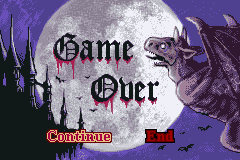
| Ovirew has been playing Castlevania games since 2001, one day after the North American release of the Gameboy Advance, with this game. Since then he has gone on to play Harmony of Dissonance, Lament of Innocence, Curse of Darkness, Dawn of Sorrow, Portrait of Ruin, Rondo of Blood and Harmony of Despair, among other Castlevania games. He was so inspired by Circle of the Moon that he once spent years working on his own comic and story based off of the plot of the game. |

Circle of the Moon will always be one of the Castlevania games I remember best, alongside the other games released for the Nintendo Gameboy Advance and DS line of systems. He didn't have the Vampirekiller Whip, but Nathan Graves sure did lay the smackdown on evil with the Hunter's Whip, and his deck of magical cards.
~ Ovirew
Log in to comment